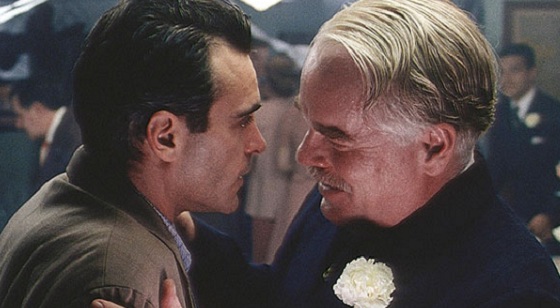

By Mike Wilmington Wilmington@moviecitynews.com
Wilmington on DVDs: The Master
PICK OF THE WEEK: NEW
THE MASTER (Also Blu-ray) (Two Discs) (Four Stars)
U.S.: Paul Thomas Anderson, 2012 (Starz/Anchor Bay)

No, I won’t call it a masterpiece — though it’s certainly a brilliant and beautiful movie, better than any other American film I saw last year. Better than Argo. Better than Lincoln. (Not by much, though.) Better than Amour. So good in fact is Paul Thomas Anderson‘s The Master that it seems to elevate your vision as you watch it, making something unforgettable out of the American landscapes and people and the events it shows us. Your eyes and heart and your mind open up. This is what movies uniquely can do — especially a film like this one, shot by Mihai Malaimare, Jr. in gorgeous 65mm, richly imagined and written and directed by Anderson, stunningly designed by Jack Fisk and David Crank, with three great performances at its center from Philip Seymour Hoffman, Joaquin Phoenix and Amy Adams, and excellent work by the rest of the cast all around them.
The Master is Anderson’s dark tale of post-war America, of a master (Hoffman), a follower (Phoenix), and the master’s wife (Adams). It’s the epic yarn of how a con-job became a big cult, and of how the seemingly placid Eisenhower-era ’50s planted the seeds that grew later into the Abbie Hoffman ’60s — the story of an explosive friendship between a charlatan and a drunk, between a preacher and a hell-raiser, sabotaged by the preacher’s determined wife. It’s my favorite Anderson film, and I‘ve liked them all, ever since his magical debut with the gambling odyssey Hard Eight in 1997, starring Philip Baker Hall, John C. Reilly, Gwyneth Paltrow and (for the first time) Hoffman,
Here, Anderson gives us another twisted American saga, in the grand but intimate vein of his last film, There Will Be Blood. That 2207 film was a deep dark portrait of America‘s young oil industry inspired by Upton Sinclair’s big, densely packed, muckraking novel “Oil!“, with Daniel Day-Lewis casting a scowling spell as an evil-hearted oilman.
The Master is a different kind of American success story. The man on the rise is Lancaster Dodd, a puffy-faced, grinning, peachy pied piper of a guy with a resonant, plummy voice you could pour over crepes, and a Cheshire grin that never fades. Dodd describes himself as “a writer, a doctor, a nuclear physicist and a theoretical philosopher.” (In other words, a superman who records and interprets the world, heals the sick, builds bombs and then tells us the meaning of it all. ) He has invented an obviously phony pseudo-philosophy, pseudo-psychology, self help scam called The Cause — a burgeoning cult seemingly modeled on science fiction/fantasy writer L. Ron Hubbard’s Scientology, but reminiscent of many a shell game with a charismatic leader.
Dodd is the Great False American Papa, worshipped because he’s a bully with a smooth, soft, paternal touch. We first see Dodd hosting a wedding on a yacht in San Francisco Harbor — the yacht is actually the Potomac, which was FDR’s private ship and later belonged to Elvis Presley, then became a drug-smuggling boat and finally a museum — and that’s the place where he meets Freddie Quell (Phoenix).
If Lancaster Dodd is smooth as silk, Freddie is a wild-ass, glinting-eyed mad outlaw of a guy who chews his lip, drinks like a school of fish, looks like a beatnik zombie and behaves like a psycho sex-crazed maniac. We’ve met Freddie before, in the movie’s rapt, violent opening scenes — as a sailor in Guam on a beach at the end of World War II, screwing a sand-woman on the South Pacific beach and masturbating into the surf; seeing nothing but inky cocks and pussies when he’s given a Rorschach test; copulating with a model in the dark room where he works as a department store photographer and chugging home-made liquor laced with paint thinner; mauling and attacking the middle-class-looking male subject he‘s photographing (while Ella Fitzgerald sings “Get Thee Behind Me, Satan“); nearly poisoning one of his fellow California fruit pickers with his mega-hooch, and finally wandering onto Dodd’s (maybe borrowed) yacht, mixing some booze, and stowing away. When he wakes up, Freddie meets Dodd, who has already decided he likes Freddie, because he likes his booze, though the stuff seems to nearly rip out his throat on the way down.
It’s love at first sight, or sip, or psych test. One of the movie’s great scenes is the shipboard Q & A interview or “process” that Dodd administers to Freddie, rattling off questions like Jack Webb without brakes, repeating his queries with jackhammer insistence until he gets the answer he wants. It’s a relentless dialogue, played like an interrogation game, batting out evil secrets. It will be echoed later on in an amazingly violent and disturbing jail scene, where Dodd and Freddie are incarcerated in adjoining cells — and the two scream at each other while Freddie tears up his cell and destroys his toilet.
Dodd is conquered by Freddie as well. We can see the depth of their palship in Freddie’s homecoming to the Dodds’ grandly front-porched home, when the two of them tumble into a bear hug, rolling all over the lawn before Dodd’s stiffer-backed family and his often pregnant wife, Peggy (Adams). Why are they such buddies? Maybe because each gets something important out of the other: beaming daddy, a wild and crazy son.
Hoffman and Phoenix are perfect in these roles, and perfectly matched (or mismatched) as well — Hoffman‘s urbane purr setting off Phoenix’s shaggy demonic tantrums. Neither actor has ever been better. Neither has had a more felicitous partner to bounce stuff off. They’re great mad foils: a phony grinning king and his dead-serious glowering clown. And Adams’ Peggy is a great villainness — probably just as demonic, in her way, as Paint-Thinner Freddie.

Paul Thomas Anderson is a fantastic screenwriter and director, and he pushes both skills to the max in The Master. It’s a wonderfully shaped and crafted film, shot with a wide-eyed beauty that can sometimes make you feel as happily drunk as Freddie. A rebel against the frenetic quick-cut style of most of the new Hollywood movies, Anderson likes to shoot long takes with a moving, roving camera. And The Master is full of those virtuoso long-take scenes — the fight in the department store, Freddie‘s stroll beside the brightly lit Potomac.
But Anderson is also good at montage, and he’s terrific here at evoking the look and feel and sound of the post-war era, weaving a marvelous quilt of romantic pop that breathes the period — from the matchless Ella to Duke Ellington‘s peerless aggregation on “Dancers in Love” or “Lotus Blossom,” to Jo Stafford’s creamy ballad “No Other Love.” (My only complaint is that Anderson didn’t include Patti Page’s “Tennessee Waltz.”)
Then there’s the way this picture is shot. Few movies of 2012 look better — and that’s not just because of Anderson’s eye, and the skills of cinematographer Mihai Malaimare (who also shot Coppola‘s Tetro and Youth Without Youth), but because of the camera they’re using: 65 millimeter — now considered almost obsolete and so little used by the industry that Anderson had difficulty rounding up cameras and stock. This is the process that David Lean used for Lawrence of Arabia, and that Kubrick used for 2001: a Space Odyssey, and that, more recently Ron Fricke used for Samsara.
All those films looked very special, very deep and rich, and so does The Master — whether we’re watching the churning waves of the ocean, or the burning rocks in the desert, or the fruit fields or the front porches, or everything else that makes up the movie’s luminous view of America. I watched an hour of The Master, and decided that (along with IMAX), that was one of the main ways I wanted to look at movies from now on. It’s an expose’ of the Eisenhower era, but it’s also a 70 mm poem to it.
But not a blind-eyed, suckered poem. Anderson focuses on Dodd the fake and Freddie the madman and Peggy the seeming good woman — and the Cause that “unites” them — because he wants to show something deeply contradictory in American culture: our tendency to deify father figures, even when they’re picking our pockets. Dodd is the master, but he’d like to be the outlaw too, if only there wasn’t a little woman to keep pulling him back to “sanity.“ The ending of The Master, criticized by some (I’ll just allude to it here, but you can consider this a semi-SPOILER ALERT) is the right, logical climax: the expressions, the schisms, the song (Frank Loesser’s “A Slow Boat to China”), and then, the last moments with two people in bed. It’s all there: Where it all begins, the false paradise where the devil lurks (Get thee behind me), where one or two or three searchers face their destiny. Don’t we all?
Did I say this movie wasn’t a masterpiece? I must have been kidding.

Extras: None.













